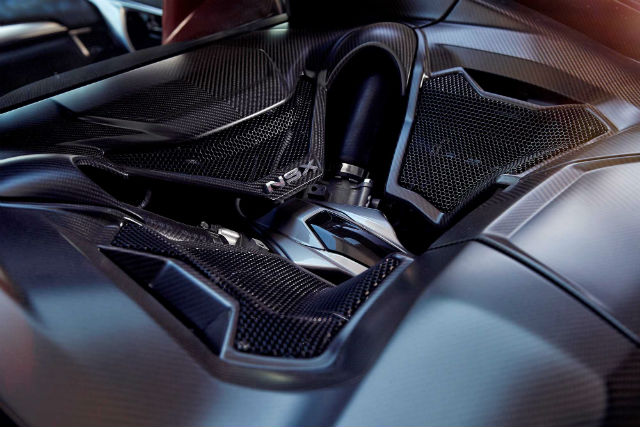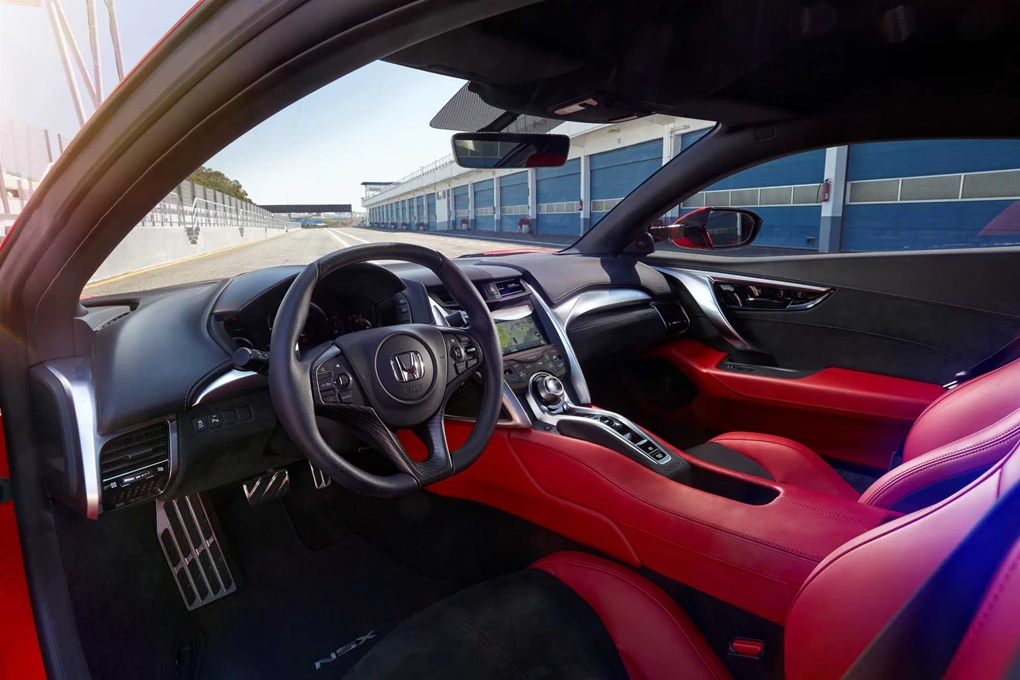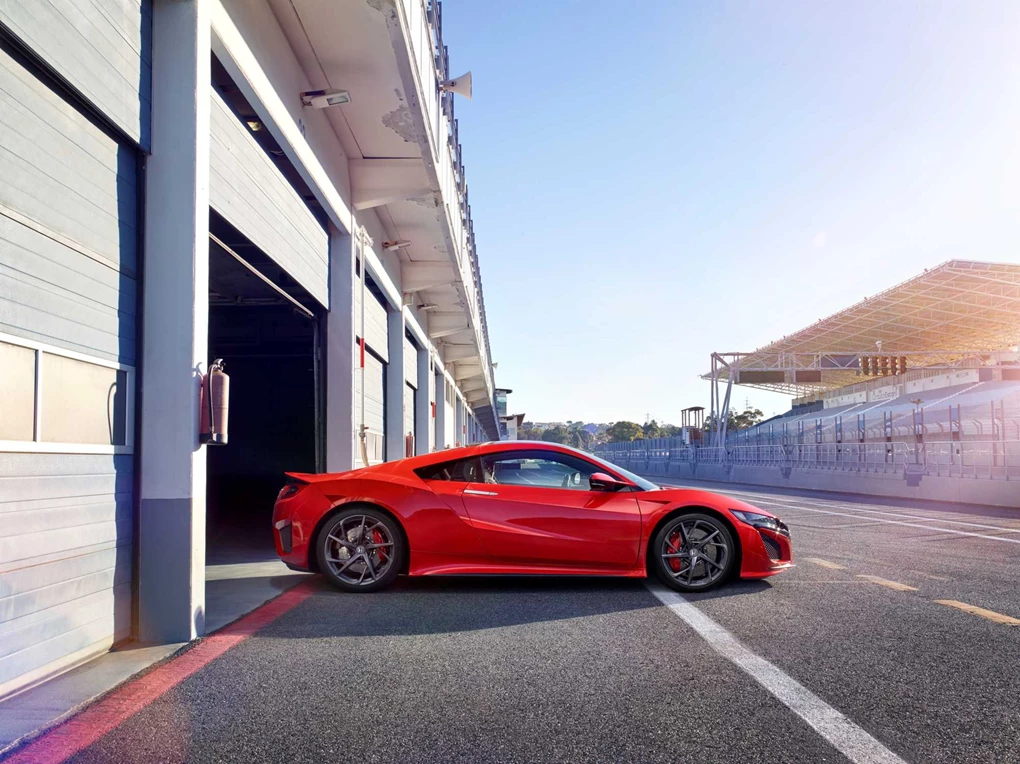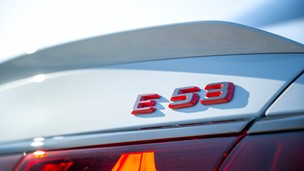It’s been quite a while since Honda last made a supercar, but what a machine it was. Called the NSX, it was built from an exotic mix of materials, the most cutting-edge construction techniques and the insight of a certain loafer-wearing Formula One champion.
To say that it changed the performance car world is hardly hyperbolic; it was like nothing else on sale at the time and it set the pace for every supercar to follow it. Now, more than 25 years later, there’s finally a follow-up, and it looks set to do for modern cars what its predecessor did in its time.
On the surface, the new NSX is the sort of car that the word mechanophilia was invented for, a ballet of aerodynamic scoops, vents and buttresses. Pictures never seem to quite do it justice, but dare we say it, in the metal it’s probably the coolest looking supercar on sale right now.
But with possibly the most advanced and sophisticated powertrain of any car around right now, it’s what’s underneath that gorgeous skin that really counts, and which really sets the NSX beyond its supercar competitors.
Performance

Of course, the NSX has been in the pipeline for a quite a while - well over a decade, in fact - and that, plus the fact that it’s been out in the US for a good length of time now, means that you should be fairly familiar with its specs.
The car consists of an aluminium spaceframe with a carbon fibre floor panel, while the rest of the car is comprised mainly of composite plastics, aluminium and carbon to make the underpinnings as light as possible. Mounted in the middle of the car is a hand-built 3.5-litre twin-turbo petrol V6, which is bolstered by no fewer than three electric motors.
The main motor is coupled to the engine and provides electrical assistance, while it also plugs the gaps in torque output when the nine-speed dual-clutch gearbox is swapping cogs. Power from the engine goes straight to the rear wheels, while each of the front wheels are driven by its own separate electric motor, essentially giving the car four-wheel drive.
Combined, the NSX is good for a total power output of 565bhp with a massive 645Nm of torque, and to say that this thing is fast is to state the outrageously obvious. Due to the fact that electric motors offer instant power, the car can launch itself to 62mph from a standing start in 2.9 seconds. 0-100 happens in just over six seconds, while it’ll rocket all the way on to 191mph when presented with enough tarmac.

For context, that’s pretty much on par with hypercars like the LaFerrari and McLaren P1, but just reading the stats on a page offers no indication whatsoever of how it actually feels to be pelted up the road with such force and such ferocity.
The instant torque slams you backwards into your seat, pinning your head against the headrest and, by the time you’ve built up the courage to look down at the instruments, you’re already in the triple figures. It’s been a long time since we’ve driven a car that’s both titillated and terrified us in such equal measure, and it really must be experienced to be believed.
The powertrain in this car really is something of a marvel in the way that it delivers such city-levelling power so smoothly and so consistently. There’s no waiting for the turbochargers to spool up, no gaps in the power delivery, just relentless acceleration from the moment you floor the throttle to the moment your courage reservoir runs dry and you inevitably back off.
Behind your head, the big V6 thrums and barks as the revs rise and fall. It’s not particularly tuneful and lacks the stratospherically revvy crescendo of the previous NSX’s naturally-aspirated engine, but there’s no doubting the purpose of the soundtrack as you’re propelled up the road.
The result is a car that’s narcotically brutal to drive, and all we can compare it to outside of other supercars is the burst of gut-wrenching acceleration you get when taking off in a jumbo jet, albeit one that’s mere inches off the ground, or alternatively like riding atop a four-wheeled bomb with your right foot on the trigger.
Ride and Handling

As if the straight-line performance weren’t incredible enough, it’s the agility and its ability to cling onto the tarmac that really impresses. While the underpinnings of the car are relatively light, once you add in the engine and all the hybrid gear it ends up quite porky, tipping the scales at around 1.7 tonnes. But, given that the electric motors mounted over the front two wheels afford it genuine, honest-to-god torque vectoring, it feels so light on its feet in a way that’s scarcely believable.
Each motor can actively juggle and adjust power and torque across the front wheels thousands of times a second under hard cornering, and in theory can keep the car perfectly balanced in any and all conditions. What that means in the real world is that the NSX can take corners at stupid speeds that would just wipe you out in virtually any other car. Thanks to its massive tyres and sticky rubber, it just grips and grips and grips, and then some.
One thing to note is that everything’s by wire in this car: drive by wire, throttle by wire and brake by wire, and so there’s no physical connection between the inputs that you’re making and what’s happening beneath you. It can take a little getting used to and you’ll need more brake pressure than you think to properly slow it down to a stop, but it’s nothing you can’t acclimatise to after a few miles. The steering’s direct and super accurate, even if it’s not particularly feelsome, while the giant carbon ceramic brake discs bite hard but modulate well. They can resist certainly any attempts we can make at getting them to fade.
Overall, the whole car feels like it’s set up with some sort of black magic that means the speed at which it can accelerate, decelerate and change direction is just surreal. Be aware, though, that on cold tyres or on a wet day, it can be an entirely different beast. The stability controls are fairly lax compared to many other cars, and it’s not unusual to end up spinning the tyres under even moderate acceleration, or fishtailing over greasy surfaces due to the sheer amount of power that’s instantly available.

It makes for a remarkably straightforward car to drive and live with day-to-day though, and despite the car’s considerable width it’s easy to place on the road and into parking spaces. The nine-speed auto gearbox is smooth, and performs well when left to its own devices even when you’re nailing the throttle, though overall the car feels easier to control and easier to get to grips with flipping up and down the cogs yourself via the steering-mounted paddles.
There’s also a choice of selectable driving modes: Quiet is your most basic mode and is handy for preventing your neighbours’ windows from vibrating on start up. Above that, there’s Sport, Sport Plus and then Track. Quiet and Sport will aim to prioritise the hybrid electric system as much as possible. Unlike the Porsche 918, there’s no proper plug-in hybrid functionality, but in lower settings the car will try to use electric power wherever it can, a handy party trick when pootling through town or cruising on the motorway.
Twist the centrally-mounted drive mode selector to the right into Sport Plus or Track and the engine will sneeze into life, with the extra electric power instead diverted towards delivering as much speed and raw force as possible, in as short a timeframe as possible. Swapping to Track opens a valve situated in the car’s intake manifold, which increases the exhaust volume by around 25 decibels, and cranks everything up to maximum attack mode: the magnetorheological dampers settle into their stiffest configuration, throttle and steering response are sharpened, maximum turbocharger boost pressure is increased and all electronic aids are switched off.
You’ll need a prescription for brave pills, then, but in Track mode the NSX truly feels like it comes alive. Ruthlessly effective is the way to describe it, from the moment you blast off via the Launch Control system to the woofle from the tailpipes on downshifts and the way the car can deliver such incredible violence while still feeling so controllable.
Interior and Equipment

Simply put, the new NSX is one very, very special car for all sorts of reasons. Unfortunately, the interior doesn’t quite measure up to the theatrics of the way it drives, or the visual drama presented by its contoured, swooping exterior. Maybe that’s not such a bad thing. For example, it’s mercifully devoid of many of the silliness that’s made supercars such a pain to live with historically.
There’s plenty of space, no silly gull-wing doors to trip over, and both the seats and the driving position are low-set but extremely comfortable. Visibility is good, aided by A pillars which are actually thinner than those on the original car, as well as by large wing mirrors which sit perched on the end of two antennae-like stalks. It’s also quite an straightforward car to get your bearings in, with the minimalist centre console easy to use and fuss free.
Of course, we can certainly understand that many would prefer it if the cabin of their supercar felt a bit more special, particularly given that they’re going to drop £130k+ on it. Naturally, most of the money goes towards that excellent powertrain, but there are a couple of places inside the car where the cracks start to show slightly. For such an obvious and likely oft-used touchpoint, the steering-mounted shift paddles feel frustratingly plasticky, while the infotainment system - the exact same one used in every other Honda car - feels like a bit of a parts bin leftover.
There’s no real places to store items in the cabin, save for a small glove compartment about the size of a letterbox. No cup holders to speak of either, which will surely frustrate drivers who stop for a morning coffee but find they have nowhere to rest it. Even the key, when compared to the 911-shaped fob of the 918, or even the multi-function touchscreen key for the BMW 7 Series, is more or less the same as that to any other Honda, save for some ‘NSX’ lettering.
Again, a small thing to complain about, but if you’re spending that much money… In the grand scheme of things though, like the original, the new NSX is a very easy car to get to grips with and you can probably overlook any shortcomings or lack of flair so long as the car drives well - and God, it does. Practicality isn’t terrific, but it’s not bad either. The 125-litre rear boot compartment isn’t terribly huge, and unlike the R8 or even the previous NSX, there’s no storage space under the bonnet. It is well shaped though, and will take a few weekend bags or even a fair amount of shopping easily enough.
Cost

The Honda NSX has a starting price of around £135,000 here in the UK, and yes, we know that that’s a lot of money to anyone. That sort of coin would buy you a very decent house in a very decent area, so it’s hard to call the NSX affordable, but for what it is it’s extremely good value. For a start, it’s less expensive than the Porsche 911 Turbo S or the Nissan GT-R Nismo, two cars which match it nearly to the letter in terms of performance, but which we don’t reckon we’re alone in thinking are just a little bit less special than the NSX.
It’s cheaper than rival supercars like the Audi R8 V10 Plus too, but it’s when you consider that this thing genuinely has the pace and technology to match the hypercar Holy Trinity for a fraction of the horsepower and at a fraction of the price that you realise just how good value it is. Of course, it’ll come as no surprise to anyone that the downside of the car is the extraordinary rate at which it consumes fuel. Honda claims that it can return up to 28mpg on average, and the electric power certainly helps, but driven with any real vigour it’ll empty its 59-litre tank in less than 100 miles.
Our Verdict

It used to be that a supercar was a one trick pony, or maybe a two trick pony at best: they went fast, and they looked good. The original Honda NSX changed all that and proved that you could have a supercar that just worked, and now the follow-up has changed the face of the supercar world yet again. Yes, the 918, P1 and LaFerrari might have beaten it to the hybrid halo car punch, but this Honda remarkably manages to pack genuine hypercar-rivalling performance for half the horsepower and less than half the price.
Like the original, it’s a monument to modern engineering and the car to make the hybrid supercar an everyday entity. Lyrical waxing aside, it’s in possession of a breadth of ability that’s genuinely astounding and speed that’ll shame virtually anything else that’s legally registered for road use. With all that new-age kit and its considerable bulk, it would have been an easy car to get wrong, but Honda has instead managed to get it so right.
Although it’s technically more of a competitor to the likes of the Audi R8, Ferrari 488 or McLaren 570S, those comparisons to the likes of the Porsche 918 are entirely justified. This is a hypercar for the masses, a tour de force of technology and engineering that represents a new era for performance cars. Will the second-generation Honda NSX be treated as kindly by history as the original? Maybe we’ll have to wait 25 years to find out, but we don’t see any reason why it wouldn’t.




